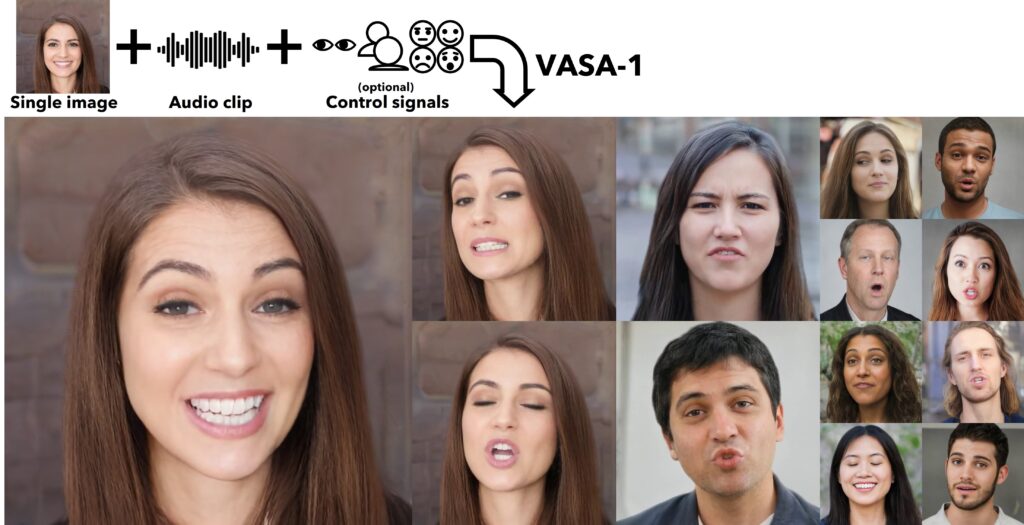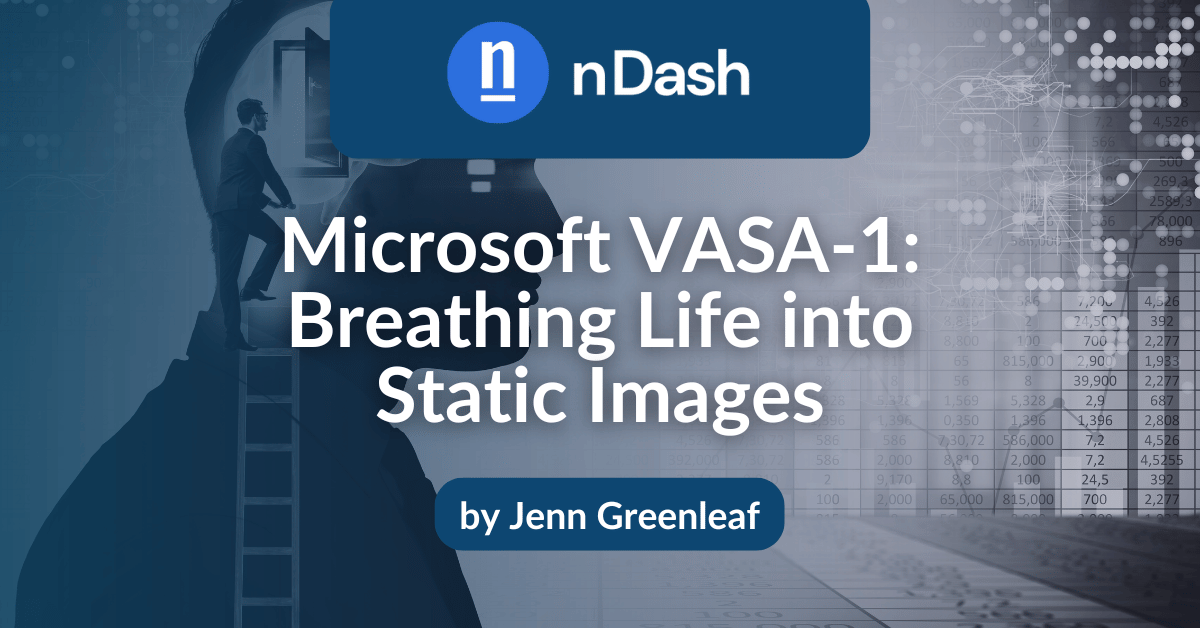Microsoft’s VASA-1 is a groundbreaking AI tool that animates static images into realistic talking head videos using just a photo and an audio clip.
Understanding VASA-1
Imagine creating a hyper-realistic talking head video from just a photo and an audio clip.
Sounds a little creepy, right?
That’s now possible with Microsoft’s VASA-1, an AI tool poised to advance video creation.
Powered by advanced AI, this tool can generate lifelike facial expressions and natural head movements. It achieves this in real time using only a single image and a speech audio file. For creators (or consumers), this technology promises to transform the way we develop (or engage with) multimedia content.

Attribute: VASA-1 – Microsoft Research
What is VASA-1?
Turning a simple photo into a talking head video? It’s not science fiction anymore; it’s what this tool does every day. (!)
VASA-1 is a technological tool that brings static images to life. It achieves this by using AI to animate facial expressions and head movements on a picture. In the process, the software makes it appear as if the person in the image is speaking.
Here’s a breakdown:
- The bigger picture (VASA): VASA stands for Video, Art, Sound, and AI. It represents a broader concept where different media elements are combined using advanced technology. It’s a specific application that falls under this umbrella.
- Focus of VASA-1: It specifically tackles the creation of talking head videos. Imagine having a picture of someone and wanting them to speak in a video. Plus, it can analyze the image and animate the face to synchronize with the provided audio, creating a realistic talking portrait.
- Benefits: It automates this process, saving creators time and effort compared to traditional methods of animating faces. It also allows for the creation of high-quality talking head videos without the need for extensive manual intervention.
How Does VASA-1 Work?
Ever wanted to see a portrait come alive and deliver a speech? VASA-1 brings static images to life by transforming a single image and an audio clip into a short video. The video features a talking face that seamlessly matches the audio.
The operation of this tool involves a few core steps, each critical to the final output:
- Image input: The system initially receives a static image of a person. This image serves as the base for the character that will be animated in the video.
- Audio input: Alongside the image, an audio file is provided. This audio contains the spoken content that the character in the video will articulate. The quality and clarity of this audio are crucial as they directly affect the synchronization and realism of the final video.
- Video generation: Combining the image and audio, VASA-1 employs a diffusion model to animate the still image, making the character speak in sync with the audio. This process involves complex algorithms that map the audio’s phonetics to the character’s lip movements, ensuring the speech looks natural.
Strange to think that a picture hanging on your wall could one day give a lecture, right?
Advanced Analysis and Subtleties
- Facial landmark recognition: VASA-1 doesn’t just focus on lips. It analyzes the entire face in the image, identifying key landmarks like eyes, nose, and eyebrows. This allows for more nuanced animations that go beyond lip movement.
- Emotion detection: VASA-1 can process the audio to understand the emotional tone. Based on this, it can generate subtle facial expressions that match the sentiment of the speech, like a smile for happiness or a frown for sadness.
- Head movement: The system doesn’t restrict the animation to just the face. It can generate natural head movements that complement the speech and overall expressiveness.
It’s a bit surreal, isn’t it? A machine understanding and mimicking human emotions from just a static image and some sound.
Technical Aspects
- Diffusion model: This is the core AI engine that powers the animation process. It works by iteratively refining the image, introducing changes frame by frame until a realistic and synchronized video is generated.
- Optional controls: While VASA-1 can operate autonomously, it might offer options to control certain aspects, such as the character’s eye gaze or head position, for more artistic freedom.
This software goes beyond simple lip-syncing by using advanced AI to create a truly lifelike experience. It analyzes the audio and image to generate facial expressions, head movements, and subtle emotional cues, resulting in a natural and engaging video.
Attribute: VASA-1 – Microsoft Research
What Makes VASA-1 Unique?
VASA-1 is a technological advancement that creates lifelike talking faces. It achieves this by synchronizing lip movements with audio and generating natural facial expressions and head movements.
Feels a bit like magic, doesn’t it? Except it’s all cutting-edge technology at play here.
Here’s what makes VASA-1 unique:
- Enhanced lip-syncing: Unlike traditional lip-syncing methods that often result in mechanical or unnatural movements, VASA-1 ensures the lip movements are perfectly synchronized with the audio, enhancing the realism of the video.
- Natural facial expressions and head movements: Beyond mere lip-syncing, VASA-1 is capable of generating natural facial expressions and subtle head movements. This capability sets it apart from other methods, as it adds a layer of authenticity and dynamism to the talking head videos, making them feel more alive and engaging to the viewer.
These features make VASA-1 a powerful tool in the video production industry. It offers an unmatched ability to create realistic and captivating talking head videos that can be used in various applications, from virtual meetings to digital marketing.
The Potential Applications of VASA-1
VASA-1, Microsoft’s innovative AI system, offers a glimpse into the future of human-computer interaction. By transforming static images into lifelike talking faces, VASA-1 opens doors to a range of exciting possibilities across various fields. Let’s explore some of the most promising applications of this groundbreaking technology.
Content Creation
VASA-1 empowers content creators to craft engaging and informative experiences. Imagine explainer videos featuring a captivating avatar that seamlessly transitions between explaining complex topics and expressing relatable emotions.
But is this a good idea? More on the ethical concerns later.
VASA-1 can even personalize pre-recorded messages, adding a human touch to birthday greetings or video presentations. Beyond explainer videos, the technology holds potential in animation and gaming, allowing for the creation of expressive characters that feel more real and responsive.
Video Conferencing
Video conferencing is poised for a significant upgrade with VASA-1. Static images used for video calls could be transformed with dynamic expressions, reflecting the user’s emotions more accurately. Background animations could also be incorporated, creating a more engaging and interactive environment.
Furthermore, VASA-1 could pave the way for the development of virtual assistants with more compelling personalities. Imagine AI assistants on video calls that not only respond to your queries but also react with appropriate facial expressions, fostering a more natural and engaging interaction.
Education and Training
The education sector stands to benefit tremendously from this tool. Imagine interactive learning experiences where students can engage with historical figures brought to life through VASA-1 technology. Complex scientific concepts could be explained by animated characters with clear and concise language.
VASA-1 could also personalize the learning experience by tailoring the avatar’s language and expressions to the student’s needs. For example, language learning apps could use this tool to create personalized scenarios with avatars speaking the target language with appropriate facial expressions, enhancing comprehension and engagement.
Accessibility Applications
VASA-1 can significantly improve accessibility for those with communication challenges. Imagine automatically generating captions that not only transcribe the spoken word but also synchronize with the speaker’s facial expressions.
This would provide a more comprehensive understanding for individuals who rely on subtitles or struggle to interpret nonverbal cues. Its ability to enhance communication holds immense potential for bridging the gap and fostering inclusivity.
Attribute: VASA-1 – Microsoft Research
The Responsible Development of VASA-1
The power of VASA-1 comes with significant responsibility. While its potential for positive applications is undeniable, its ability to manipulate video raises serious ethical concerns. This section explores the potential for misuse and Microsoft’s approach to responsible development.
It’s a tool that could change history or rewrite it—literally. A thought that’s as exciting as it is scary, don’t you think?
Potential Misuse and Ethical Concerns
Its ability to generate lifelike videos raises concerns about deepfakes. Malicious actors could use the technology to create fake videos of politicians or celebrities, potentially swaying public opinion or damaging reputations.
Additionally, manipulating existing videos could spread misinformation or be used for harassment or fraud. Privacy considerations are also crucial. VASA-1’s reliance on source material raises questions about the potential misuse of identities and the unauthorized creation of deepfakes.
Microsoft’s Approach to Responsible Development
Recognizing these risks, Microsoft has chosen not to release this tool to the public. This decision prioritizes responsible development and underscores the importance of establishing regulations and ethical frameworks before the widespread use of such powerful AI tools.
Microsoft acknowledges VASA-1’s potential benefits but believes it’s crucial to address potential harms before unleashing this technology on the world.
VASA-1: Ushering in a New Era of Human-Computer Interaction
VASA-1’s potential is vast, enhancing various applications while necessitating careful consideration of ethical implications to ensure responsible and beneficial technology development.
